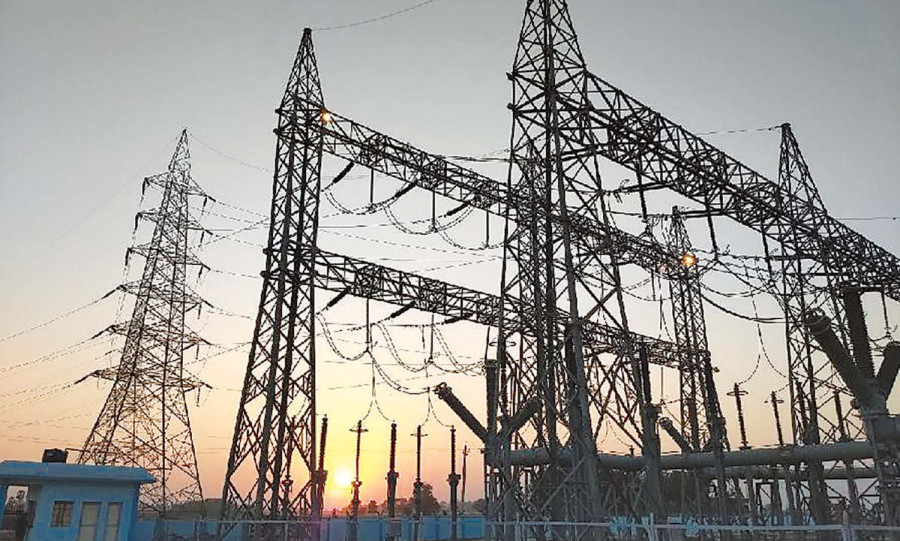National
New deal opens door for export of another 300MW electricity to India via Bihar
Nepal will be able to sell 1,100 megawatts subject to approval from Indian authorities.
Prithvi Man Shrestha
India has opened the door for Nepal to sell an extra 300MW electricity in the Indian market using the transmission lines in the neighbouring Bihar state, a senior official of Nepal Electricity Authority said.
With Nepal being allowed to sell power in the Indian market only through the 400kV Dhalkebar-Muzaffarpur Transmission Line so far, opening of new routes will enable the country to sell more power in the southern market.
“An agreement between the Nepal Electricity Authority (NEA) and the PTC India Ltd was signed on June 28, paving the way for us to use Bihar’s transmission infrastructure to sell 300MW of power in the Indian market,” Prabal Adhikari, power trade director at the NEA, told the Post.
In an interview with the website livemint.com, PTC India’s Chairperson and Managing Director Rajib Kumar Mishra confirmed the agreement.
“We have recently signed a PPA [Power Purchase Agreement] for 300MW with Nepal Electricity Authority to bring more power from Nepal via Bihar. Earlier, Bihar used to export power, but for the first time we will import via transmission lines in Bihar. It should start this wet season but for that some conditions need to be met,” he said in the interview. “We will decide on the procurer as and when demand comes. It is a flexible arrangement. We are trying to find buyers. We may either sell to exchanges, or directly to the buyers.”
This agreement will pave the way for Nepal to sell a total of 1,100MW electricity in the Indian market with two neighbours already agreeing to transmit up to 800MW through the Dhalkebar-Muzaffarpur line.
During the 10th Joint Steering Committee (JSC) meeting held in February in Rajasthan, India, the two sides had agreed to increase the quantum of traded power through the Dhalkebar-Muzaffarpur Transmission Line from 600MW to 800MW, Nepal’s Ministry of Energy, Water Resources and Irrigation said in a statement.
Adhikari said that the agreement with the PTC India was signed as per the understanding reached with the Indian side during the 10th JSC meeting. “We had asked the Indian side to allow Nepal to export power in the Indian market using Bihar’s transmission infrastructure while promising to pay the transmission fee or wheeling charge,” he said.
During the 10th JSC meeting, the two countries had agreed to prepare a mechanism to export Nepal’s power to India with 132KV or less capacity cross-border transmission line.
There are four 132kV cross border transmission lines connecting Nepal and Bihar state of India excluding the 400kV Dhalkebar-Muzaffarpur line. These lines are being used only for the exchange of power between Nepal and Bihar, according to the NEA.
Under this arrangement, whenever Nepal needs power from India, it can import it from the Indian state and when Bihar needs some power, it can take it from Nepal.
“For the first time, these transmission lines will be used for trading of power,” said Adhikari. He said that because of excess generation of power in Nepal in the wet season and Bihar not taking all that excess power generated in Nepal under exchange arrangement, Nepal wanted to use Bihar’s transmission infrastructure to sell power in India’s energy exchange market, enabling the NEA to sell to any state connected with Bihar.
There are four 132kv cross-border power lines between Nepal and Bihar: Kataiya-Kusaha (old), Kataiya-Kusaha (New), Raxaul-Parwanipur and Ramnagar-Gandak.
But Nepal will not be able to sell in the Indian market through Bihar’s transmission infrastructure immediately, with the country requiring project specific approval from the Indian authorities.
“We are now preparing to propose a few projects from which to sell power through Bihar’s transmission infrastructure,” said Adhikari. The southern neighbour has so far allowed Nepal to sell 452.6MW of electricity in its power market by taking the power through the Dhalkebar-Muzaffarpur cross-border power line.
Nepal’s efforts to get approval for additional hydropower projects for export has so far been unsuccessful due to the bureaucratic hurdles in India.
Along with the arrival of monsoon, Nepal’s hydropower projects have started to generate around 2,200MW, according to the power utility. But peak domestic demand stood at 1,871MW on Tuesday, according to the NEA.
Demand however slumps in the mid-night and the country has been facing power spillage for some hours every day, according to the NEA.
Nepal’s request for approval from the Indian authorities for 18 hydropower projects with a combined capacity of over 1,000MW has been pending for two years. “We want India’s early approval for more of Nepal’s power projects in order to sell more in the Indian market,” said Adhikari.




 5.83°C Kathmandu
5.83°C Kathmandu








%20(1).jpg&w=300&height=200)





